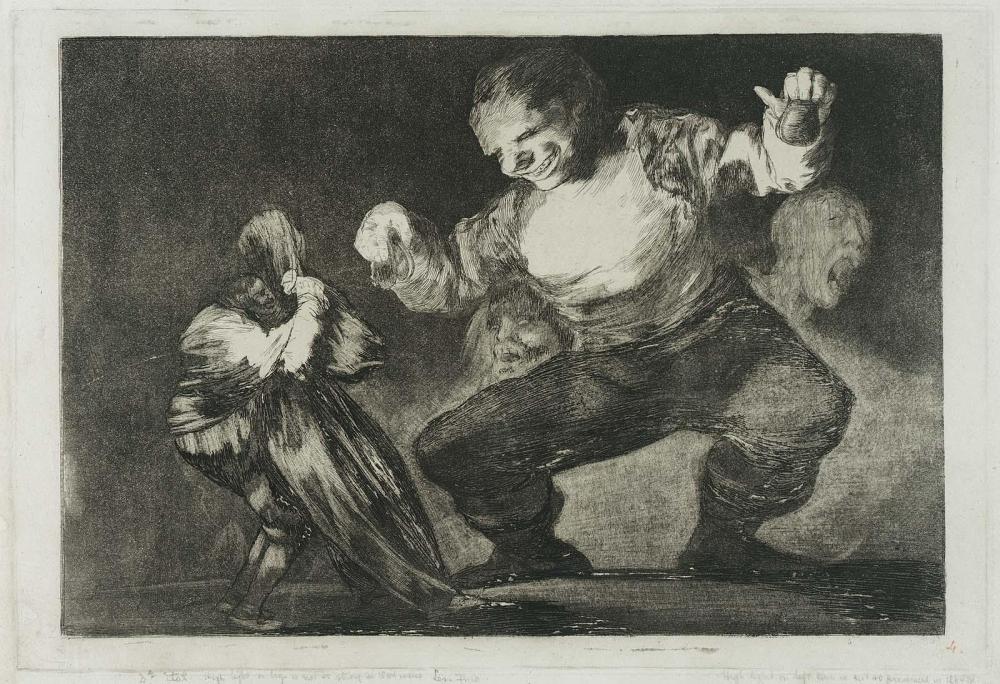Advanced Search 
The Dancing Giant

Giant; from the "Disparates" series, plate 4
The Dancing Giant
Francisco Goya y Lucientes (Spanish, 1746–1828)
Drawn and etched about 1816-19; printed about 1848 - 54
Medium/Technique
Etching, burnished aquatint, lavis and/or emery stone, tonal scratches, and burin; posthumous impression, trial proof.
Dimensions
Platemark: 24 x 35.3 cm (9 7/16 x 13 7/8 in.)
Sheet: 26.2 x 37.5 cm (10 5/16 x 14 3/4 in.)
Sheet: 26.2 x 37.5 cm (10 5/16 x 14 3/4 in.)
Credit Line
Museum purchase with funds by exchange from the bequest of Horatio Greenough Curtis and the Harvey D. Parker Collection—Harvey Drury Parker Fund
Accession Number1973.701.4
NOT ON VIEW
CollectionsEurope, Prints and Drawings
ClassificationsPrints
Catalogue Raisonné
Harris 251, II, 1; Delteil 0205
DescriptionGray/black ink, clean-wiped, Bevelled plate edges.
Posthumous impression with burnished aquatint, additional etching, lavis and/or emery stone, burin, and tonal scratches, scratch at left from back of man to edge.
From a pre-publication lighlty bound set of 18 prints With a tan paper cover with the inscription "GOYA / Los Proverbios / Madrid hacia 1848".
Sheets are uniformly slightly textured, medium, grayish cream wove.
The preferred series title "Disparates" (Follies) is derived from manuscript titles containing the word "Disparate" on fourteen of the working proofs, of which this is one. Beruete and others invented titles containing "Disparate" for the rest, except "Modo de volar" (no. 13).
Posthumous impression with burnished aquatint, additional etching, lavis and/or emery stone, burin, and tonal scratches, scratch at left from back of man to edge.
From a pre-publication lighlty bound set of 18 prints With a tan paper cover with the inscription "GOYA / Los Proverbios / Madrid hacia 1848".
Sheets are uniformly slightly textured, medium, grayish cream wove.
The preferred series title "Disparates" (Follies) is derived from manuscript titles containing the word "Disparate" on fourteen of the working proofs, of which this is one. Beruete and others invented titles containing "Disparate" for the rest, except "Modo de volar" (no. 13).
Inscriptionsl.r. in red chalk,(not Goya) "4"; below graphite cataloguing notations and descriptions
ProvenanceAbout 1928, Emil Hirsch (dealer; b. 1866 – d. 1954), Munich and New York; by 1950, sold by Hirsch, or by his son-in-law, Hellmuth Wallach (dealer; b. 1901 – d. 1989), Munich and New York, to Philip Hofer (b. 1898 – d. 1984), Cambridge, MA [see note 1]; 1973 , sold by Philip Hofer, through R. M. Light, Boston, to the MFA. (Accession Date: June 13, 1973)
[1] There is a note on the flyleaf for this set of prints (MFA accession nos. 1973.701.1-18) in Philip Hofer’s hand that reads: "Bought years ago - ca. 1928 – Emil Hirsch in Munich". It is unclear precisely what Hofer’s note means. Hirsch was a Jewish rare book dealer in Munich, who was forced to close his business in May of 1937. He immigrated to the United States in 1938. His son-in-law, Hellmuth Wallach, likewise a dealer, fled Munich in 1937 and worked with Hirsch (at Emil Hirsch Rare Books and Prints) in New York beginning in 1938. According to Emanuel von Baeyer, The Hellmuth Wallach Collection: From the Master of the Tarocchi Cards to Manet (London, 2016), p. 122, Wallach sold the set of prints to Philip Hofer. Hofer first lent them to the MFA in 1950.
[1] There is a note on the flyleaf for this set of prints (MFA accession nos. 1973.701.1-18) in Philip Hofer’s hand that reads: "Bought years ago - ca. 1928 – Emil Hirsch in Munich". It is unclear precisely what Hofer’s note means. Hirsch was a Jewish rare book dealer in Munich, who was forced to close his business in May of 1937. He immigrated to the United States in 1938. His son-in-law, Hellmuth Wallach, likewise a dealer, fled Munich in 1937 and worked with Hirsch (at Emil Hirsch Rare Books and Prints) in New York beginning in 1938. According to Emanuel von Baeyer, The Hellmuth Wallach Collection: From the Master of the Tarocchi Cards to Manet (London, 2016), p. 122, Wallach sold the set of prints to Philip Hofer. Hofer first lent them to the MFA in 1950.
